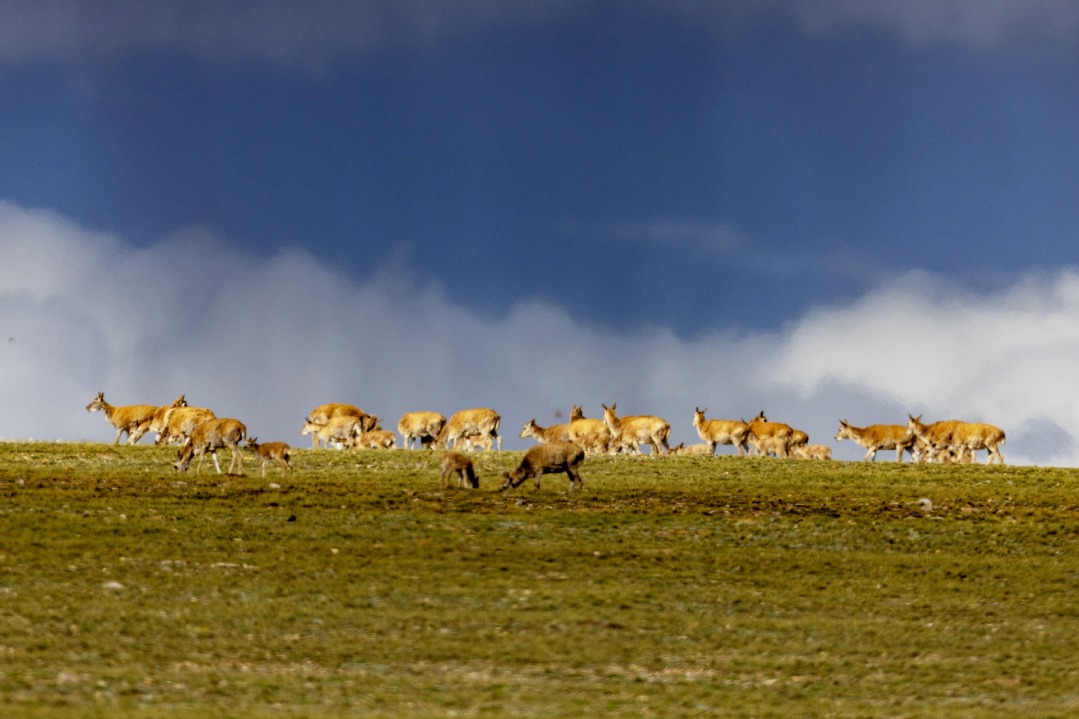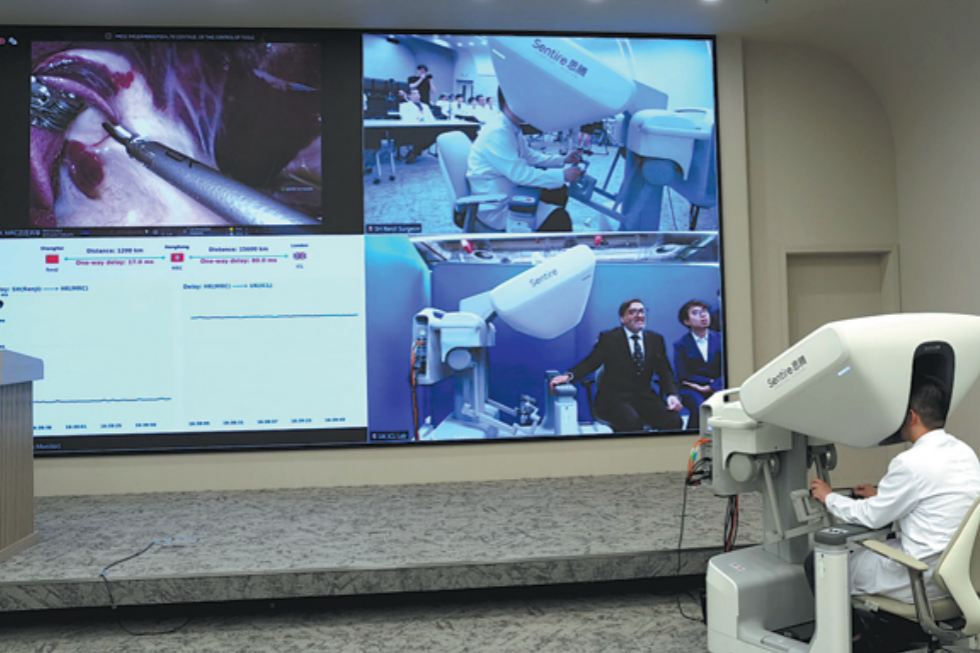A space odyssey
What started off as a hobby soon turned into a passion for meteorite collector as she enchants and educates visitors to her facility with rocks that have made a spectacular journey, Yang Feiyue reports.

It's hidden away, almost as if it's shy about what it has to show. It can boast a collection of items that are, literally, out of this world. Its discreet location is in a bustling neighborhood famous for its antiques and it attracts visitors from all walks of life who examine its contents.
All the noise and bustle from the street, where the price of antiques are debated and negotiated, gives way to a, pardon the pun, otherworldly serenity once one enters the facility, in the Nanming district of Guiyang, capital city of Southwest China's Guizhou province.
Its shelves do not strain under the weight of books or delicate ceramics, stone sculptures, jewels or jadeware. What it has are stones from the sky-meteorites of various shapes and sizes.
They were all collected by Yang Kexin, a 30-year-old Guizhou resident, who runs the facility as a small museum to share her knowledge about meteorites with visitors.
Yang's passion for the subject began eight years ago, while working at a mining equipment company in Hami prefecture, Northwest China's Xinjiang Uygur autonomous region, that she joined after graduating from high school.
"I had to visit mining zones a lot, and the Gobi desert was all around us," Yang says.
She then realized the locals, and her colleagues, were fascinated by the meteorites and other rocks and minerals, and would go into the desert to find them.
Yang joined them, at first for fun.
"The trips were amazing, and everyone had to prepare enough water, food and a tent, as well as a GPS and a walkie-talkie," she says.
Yang's interest peaked when one of her friends picked up a meteorite in 2013.
"I couldn't have been more thrilled and immediately went to see it," Yang recalls. "It looked like a black rock, but I could instantly tell it was different to other stones."
The encounter reignited her passion for meteorites that had first surfaced in childhood.
"I had always considered meteorites out of reach and mysterious, each having its own story to tell," Yang says.
The first sight of the real meteorite then prompted Yang to find out more about them.
When she understood just how difficult a journey it was for a meteorite to pass through the atmosphere and actually fall to Earth, she knew that her life was about to change.
From then on, Yang started to hunt for meteorites.
In China, meteorites are most likely to be found in the deserts of Gansu province, and the Xinjiang Uygur and Inner Mongolia autonomous regions.
However, knowing where they are likely to fall and actually locating them are two different things.
The phrase mentioning a needle and a haystack comes to mind, Yang says.
"One is exposed to the sun, not to mention the sandstorms and occasional wild animal attacks."
From 2012 to 2017, Yang trekked more than 100,000 kilometers across Xinjiang, including through China's largest desert, the Taklimakan, as well as traversing the Kumtag Desert and scaling the Alatage Mountain.
Gaining survival skills
In 2012, Yang had a close call during her first trip hunting meteorites in Lop Nur, a former salt lake in Xinjiang.
"I had no experience in no man's land, and was concentrating on scanning the ground (for meteorites), without noticing I was distancing myself from the team," recounts Yang.
"I panicked. I could not see anyone from my team in the seemingly boundless Gobi desert."
It was the first time she felt desperation and was fearful for her life, she says. Fortunately, she found the tire tracks of the vehicles and hiked for more than three hours before she spotted a headlight.
"I screamed and waved, and my friends found me," she recalls.
She has since then made a point of learning survival skills for every imaginable contingency, such as sudden sandstorms or if the car gets stuck in the desert sand.
After years of research and study, Yang's meteorite tracking skills have blossomed.
"The fresh ones just falling from the sky will often carry a thin black shell, while those weathered by the wind will have a touch of brown mixed into them," Yang says. "You can just tell after spending time looking for them."
The biggest meteorite she found was at Alatage Mountain in Xinjiang. It weighed more than 30 kilograms and is believed to have fallen to Earth more than 100 years ago.
But finding one is only half the battle. Once Yang locates a meteorite, she has to make notes of coordinates and measure its weight, before searching for more pieces that may have broken up as the rock plummeted.
"You can't miss even one of just a few grams," Yang says, adding that they could be part of a whole piece and help determine the trajectory.
She spent two years from 2013 recovering more than 200 meteorites that belong to the same larger rock in Ruoqiang county, Xinjiang.
Giving off the vibe
Over the years, she has found more than 600 meteorites with a cumulative weight of 400 kilograms.
In 2017, Yang went back to her hometown Guiyang and opened the meteorite facility.
There she displays more than 300 of the meteorites she has found, along with accessories made from them.
A sand table demonstrating the scattered meteorite belt in Lop Nur stands in the center of the facility.
"I tried to re-create the scene and the environment to enable more people to understand and like meteorites," Yang says. "I've met visitors from different parts of the country, and I shared my stories of each of the meteorites and major scientific information behind them. Visitors showed much interest."
Access to the facility is free and Yang says she makes an income from selling accessories related to, or made from, the meteorites.
It has evolved into an educational facility for meteorite culture and science over the years and is now an internship site for postgraduate students from the Institute of Geochemistry, the Chinese Academy of Sciences.
"It's delightful to attract astronomy enthusiasts and the general public to experience the mystery of the universe at close quarters," Yang says.
She has also become an outdoor tutor for students from the Center for Lunar and Planetary Sciences at the Institute of Geochemistry and helps arrange field trips for students to expand their knowledge beyond the textbook.
Facilitating understanding
She has only recently returned from a scientific expedition to Xinjiang in October with a team of students from the institute, and managed to recover more than 30 meteorites.
Yang is often invited to give lectures at local primary schools and companies in Guiyang.
"I want to help students learn more about the universe and hope that they get interested in exploring it," Yang says.
To date, China has recovered 12,665 meteorites from the Antarctic, following the United States and Japan in collections, says Chen Hongyi, vice-curator of the geological museum with the Guilin University of Technology in South China's Guangxi Zhuang autonomous region.
"Yang's work is very meaningful," says Chen.
Planetary science is in the process of becoming the first-class discipline across the country, while meteorites contain clues for the human race to better understand the moon, Mars and the rest of the solar system, and possibly find extraterrestrial life, Chen explains.
Those meteorites are the only material samples from the wider universe that humans can touch while on Earth, except for those acquired from space, Chen explains.
During the Apollo space program, which first put men on the moon, the US landed 12 astronauts over six flights between 1969 and 1972, bringing back 382 kilograms of rocks and soil.
The former Soviet Union deployed three successful robotic sample return missions in the 1970s. The last, Luna 24, retrieved 170.1 grams of samples in 1976 from Mare Crisium, or "Sea of Crises" on the moon.
China's Chang'e 5 probe, launched in late November, is currently on a mission to collect samples from the moon.
Speaking about Yang's work, Chen says she has played a very positive role in publicizing meteorite knowledge, especially among young people.
"Yang has donated a few meteorites to our museum, providing more samples for people to better learn about these rocks."
Chen says he knows dozens of meteorite hunters like Yang across the country.
"They feel a close bond with these rocks, and want more people to like meteorites, thus contributing to the development of a network for meteorite knowledge popularization."
Speaking about her future plan, Yang says she is looking forward to reaching more students with her meteorite knowledge and helping them to understand the universe, while taking care of her meteorite facility.


Today's Top News
- Premier stresses high-quality implementation of major national projects
- Syrian interim govt begins phased implementation of ceasefire in Sweida
- Mayors from around the world gather in Qingdao for dialogue
- Premier announces construction of Yarlung Zangbo hydropower project
- Digital countryside fueling reverse urbanization
- 'Sky Eye' helps unlock mysteries of the universe






























